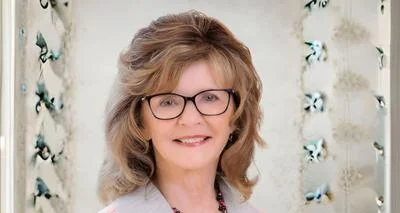Contributed photo | illinois.edu
Contributed photo | illinois.edu
University of Illinois at Urbana Champaign issued the following announcement on June 13
A town planning session facilitated by University of Illinois Extension staff blossomed into a project that attracted hundreds of volunteers, fed dozens of families, and became a point of pride for an economically distressed neighborhood.
The Mount Vernon Community Gardens, located in the town’s Veterans Park, are part of an 86-acre oasis that is situated in a neighborhood where 30% of residents live below the poverty line, according to U.S. Census data. That’s nearly twice the Jefferson County rate and more than double that of the U.S.
The project launched in 2016 when Mount Vernon City Councilman Donte Moore and others invited Pam Schallhorn, Extension community and economic development specialist, to lead a town hall meeting aimed at envisioning such a garden. Schallhorn, like other Extension educators, uses Extension's Community Planning Program to provide evidence-based training in community and economic development to local community leaders, economic development professionals, and other stakeholders.
More than 35 Mount Vernon residents showed up for that first meeting. They left motivated and excited. One resident launched a Kickstarter campaign that raised $4,200 in 30 days. The city council designated the Veterans Park space. As construction began, volunteers showed up in droves. Businesses provided tools, machinery, services, and expertise.
“We had a local plumbing company offer to do all of the water for free,” said Schallhorn. “The town has 13,000 people. Hundreds of them worked on this, an incredibly diverse representation of folks. Everybody felt like that garden was theirs.”
Schallhorn paired her extensive background in community and economic development with her project management skills to support the community effort. Spearheading a collaborative movement, she worked with Extension staff from multiple disciplines, local volunteers, government agencies, and businesses to help smooth the project’s path.
Volunteers created a garden shaped like a wagon wheel, initially with 17 beds. The design was meant to expand ever outward, like the community. Relationships were expanding outwards, too, as people broke down invisible barriers in pursuit of a common goal. Now, fresh vegetables are grown in 40 beds, more than double the original number.
“When this first started, I just thought it was something that neighborhoods could rally behind,” Moore says. “And then, you get a bunch of people together to plan something like this, and they start to forget about all the negative things that are going on today. They start to talk about things that are important, asking each other, ‘How’s your day? How is your family?’ Things changed."
Moore’s observation is borne up by research. According to the American Community Gardening Association, community gardens provide a host of benefits, including increased neighborhood cohesion, grassroots leadership, and reduction in crime rates. They also strengthen cooperation, friendship, and understanding among diverse groups, while providing a place for people to produce wholesome, nutritious food despite their circumstance, where they live, or whether they have yards or homes.
"Community gardens, like the one we continue to grow here in Jefferson County, have the power to transform the way we care for ourselves, each other and our land for generations to come," said Rachel Hunsell, a Mount Vernon community member. "I hope to continue to play a role in projects like this one for many years to come, in my community, in the hopes we can continue to improve the way we live and thrive alongside one another, and care for the land on which we live."
Other benefits extend to young gardeners, who can gain job skills, budgeting experience, learn about environmental sustainability, and begin to understand the complexities of food production. Best of all, community gardens improve nutrition for families that need such support.
Ashley Hoffman is an Extension educator with the Supplemental Nutrition Assistance Programs education program.
“The gardens are located in a food desert,” she says. “This means people who live there have limited access to affordable and nutritious foods. So, they may not be able to buy fresh produce regularly, or they may rely on a nearby gas station for some of their groceries, and this puts them at increased risk, including diabetes or heart disease."
In Illinois, more than 1. 2 million people are food insecure. Of those, 12.7% are children.
Supplemental Nutrition Assistance Programs Education teaches people how to boost nutrition value while stretching their food dollars. Nearly 1.8 million Illinoisans are SNAP recipients. These individuals may frequent food banks to feed their families. But such facilities often have difficulty securing fresh produce, Hoffman says. The Mount Vernon Community Gardens make a difference here as well.
“The gardens’ ‘no food waste policy’ enables any extra food produced to be harvested and given to local food banks,” says Chris Lueking, an Extension program coordinator who serves Jefferson and surrounding counties. As program coordinator for the Mount Vernon Community Gardens, she works with Hoffman, Schallhorn, other Extension educators and the community to ensure success. “People can garden in their own plots, but if they don’t harvest, our volunteers are allowed to do so and donate the produce to the food pantries.”
“Any time we go to the food pantry with the donation, they are so excited because it’s difficult to acquire fresh produce to give out to their food pantry clients," says Hoffman. “That, for me, is the biggest success.”
After the first year, Lueking decided a celebration was in order, so she and others organized “Pick or Treat,” an outreach event to showcase the community gardens while enabling families to choose their plot for the next season.
Children dressed up in costumes, navigated a maze, and got their faces painted. Guests chatted with police officers, fire fighters and others in the service industries. SNAP-Ed showed up to offer healthy snacks paired with nutritional information, and a photographer took family pictures for free. As music played, community members gave tours, providing educational information and gardening tips they’d learned, while guests sipped apple cider donated by the owner of a local orchard.
There were other community events, too, including a Farm-to-Table event that raised another $2,000 for the gardens, and an ongoing educational series presented by an Extension educator and containing research based information about gardening.
“The series went over gardening basics: soil health, pest and weed control, disease and insect management, companion planting, and other topics,” Lueking said. “It was free to the public, and anyone from the community could come."
The Mount Vernon Community Gardens did not escape the impacts of the COVID-19 crisis, but even then, the community rallied to respond. Volunteers planted and maintained cover crops to ensure the health of the beds during a year of COVID-19 restrictions. Extension educators encouraged and informed virtually, offering information on Facebook and other social media channels. Together, they planned for post-pandemic times, the slow return to community spaces, and a focus on sustainability.
Everyone cheered when a few gardeners, unable to tend their community beds, produced successful backyard harvests, by planting vegetables at home for the first time in their lives.
“The City Council created a resolution that ensures that the community gardens will be in Veterans Park forever, for time immemorial,” Schallhorn says, her voice catching as she considers the longevity of the statement. “All this came from one request to a CED educator to come in and do a visioning session. That work was continued with the help of other Extension professionals, local volunteers and businesses, and the community created something that will be there forever. All because of one request.”
Moore, who made that request, grew up on the south side of Mount Vernon, in the neighborhoods now near the community gardens. Everyone had gardens then, he remembers, and back then, kids ran around the streets in summer evenings, playing with each other as neighbors shared news, and harvests, on front porches and over back fences.
“I wanted to bring that nostalgia back,” he says. “I always think about the things I grew up with. I know it’s a different time, but the past can teach you about the future."
Moore credits the community gardens with making educational and social impacts in his old neighborhood. Now, he says, grandmothers share nutritional information with children and encourage them to adopt healthy eating habits.
“That’s how it’s supposed to be,” he says. “The community gardens started bringing people together. You know, once you reach one, you teach one. And this project promotes community awareness. It promotes conversation. It promotes people getting to know each other again. That’s what I hoped it would do.”
Original source can be found here.






 Alerts Sign-up
Alerts Sign-up